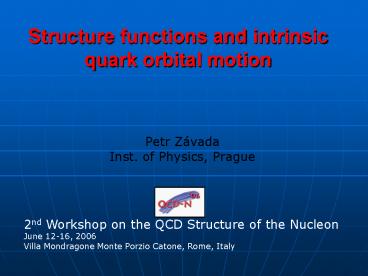Structure functions and intrinsic quark orbital motion - PowerPoint PPT Presentation
Title:
Structure functions and intrinsic quark orbital motion
Description:
Structure functions and intrinsic quark orbital motion Petr Z vada Inst. of Physics, Prague 2nd Workshop on the QCD Structure of the Nucleon June 12-16, 2006 – PowerPoint PPT presentation
Number of Views:135
Avg rating:3.0/5.0
Title: Structure functions and intrinsic quark orbital motion
1
Structure functions and intrinsic quark orbital
motion
- Petr Závada
- Inst. of Physics, Prague
2nd Workshop on the QCD Structure of the
NucleonJune 12-16, 2006 Villa Mondragone Monte
Porzio Catone, Rome, Italy
2
Introduction
- Presented results are based on the covariant QPM,
in which quarks are considered as quasifree
fermions on mass shell. Intrinsic quark motion,
reflecting orbital momenta, is consistently taken
into account. P.Z. Phys.Rev.D65, 054040(2002)
and D67, 014019(2003). - Recently, this model was generalized to include
the transversity distribution A.Efremov,
O.Teryaev and P.Z., Phys.Rev.D70, 054018(2004)
and arXiv hep-ph/0512034. - In this talk
- Relation between structure functions and 3D quark
momenta distribution - Important role of quark orbital motion as a
direct consequence of the covariant description
3
Model
4
Structure functions
- Input
- 3D distribution
- functions
- Result
- structure
- functions
5
Comments
- In the limit of static quarks, for p?0, which is
equivalent to the assumption pxP, one gets usual
relations between the structure and distribution
functions like - Obtained structure functions for m?0 obey the
known sum rules
Sum rules were obtained from 1) Relativistic
covariance 2) Spheric symmetry 3) One photon
exchange
- In this talk m?0 is assumed.
6
Comments
Structure functions are represented by integrals
from probabilistic distributions
- This form allows integral transforms
- g1 ? g2 or F1 ? F2 (rules mentioned above were
example). - With some additional assumptions also e.g.
integral relation g1 ? F2 can be obtained
(illustration will be given). - To invert the integrals and obtain G or H from
F2 or g1 (main aim of this talk).
7
g1, g2 from valence quarks
8
g1, g2 from valence quarks
E155
Calculation - solid line, data - dashed line
(left) and circles (right)
- g1 fit of world data by E155 Coll., Phys.Lett B
493, 19 (2000).
9
Transversity
- In a similar way also the transversity was
calculated see A.Efremov, O.Teryaev and P.Z.,
Phys.Rev.D70, 054018(2004). - Transversities obtained above were used for the
calculation of double spin asymmetry in the
lepton pair production in proposed PAX
experiment see A.Efremov, O.Teryaev and P.Z.,
arXiv hep-ph/0512034).
10
Double spin asymmetry in PAX experiment
1.
2.
11
Quark momenta distributions from structure
functions
- 1) Deconvolution of F2
- Remarks
- G measures in d3p, PG in the dp
- pmaxM/2 due to kinematics in
- the proton rest frame, ?p0
- F2 fit of world data by SMC Coll., Phys.Rev. D
58, 112001 (1998).
12
Quark momenta distributions
- 2) Deconvolution of g1
- Remark
- HD-D- represents subset of quarks giving net
spin contribution opposite polarizations are
canceled out. Which F2 correspond to this subset?
One can calculate
13
Quark momenta distributions
- Comments
- Shape of ?F2 similar to F2val
- Generic polarized and unpolarized distributions H
and G are close together for higher momenta,
- Mean value
- Numerical calculation
- g1 fit of world data by E155 Coll., Phys.Lett B
493, 19 (2000).
14
Intrinsic motion and angular momentum
- Forget structure functions for a moment
- Angular momentum consists of jls.
- In relativistic case l,s are not conserved
separately, only j is conserved. So, we can have
pure states of j (j2,jz) only, which are
represented by relativistic spherical waves
15
j1/2
16
Spin and orbital motion
17
Comments
- for fixed j1/2 both the quantities are almost
equivalent - more kinetic energy (in proton rest frame)
generates more orbital motion and vice versa.
- are controlled by the factor
, two extremes - massive and static quarks
and
- massless quarks
and
- important role of the intrinsic quark orbital
motion emerges as a direct consequence of the
covariant approach
18
Summary
- Covariant version of QPM involving quark
orbital motion was studied. New results - Model allows to calculate 3D quark momenta
distributions (in proton rest frame) from the
structure functions. - Important role of quark orbital motion, which
follows from covariant approach, was pointed out.
Orbital momentum can represent as much as 2/3 j.
The spin function g1 is reduced correspondingly.
19
Sum rules
- Basis
20
Manifestly covariant form
where































